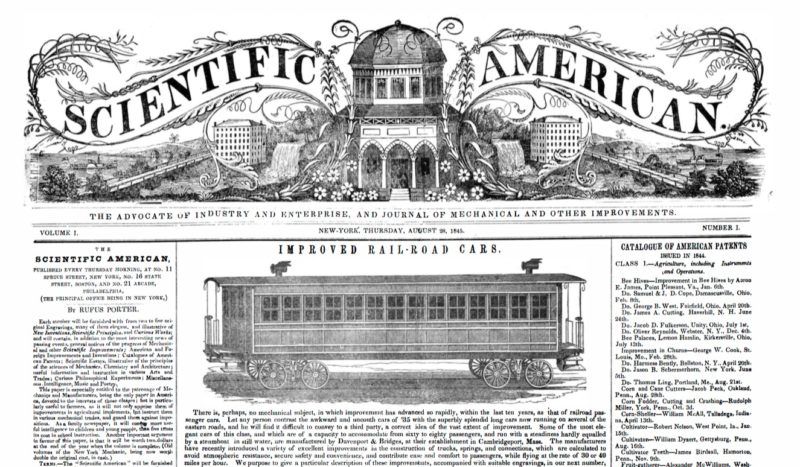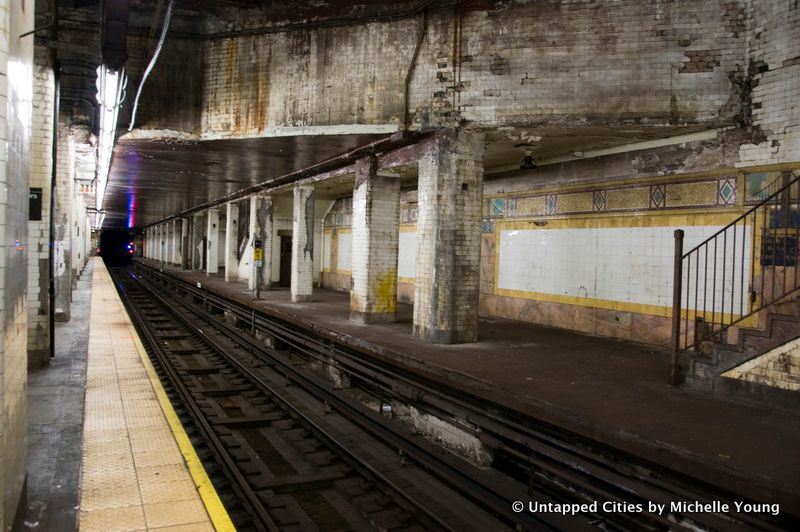How to See the Liberty Bell...in Queens
A copy of the famous American bell can be found inside a bank, which itself is modeled after Independence Hall!


Top half of the front page of Scientific American’s first edition published on Thursday, August 28, 1845. Image source Wikipedia Commons.
On August 28, 1845 the first edition of Scientific American was published at 11 Spruce Street by 19th century Renaissance man, Rufus Porter.
The magazine, still in circulation today, started as the New York Mechanic in 1841 with the subtitle, “The Advocate of Industry and Enterprise and Journal of Mechanical and Other Improvements.” Porter bought a share of the magazine and moved it to Boston changing the name to American Mechanic. In 1845 he moved his operations back down to New York City and did a complete rebranding of the magazine calling it Scientific American. Although it was also published concurrently in Boston and Philadelphia, Porter’s Spruce Street office was considered the magazine’s headquarters.
Here’s an excerpt from the first edition:
Scientific American published every Thursday morning at No. 11 Spruce Street, New York, No. 16 State Street, Boston, and No. 2l Arcade Philadelphia, (The principal office being in New York) by Rufus Porter. Each number will be furnished with from two to five original Engravings, many of them elegant, and illustrative of New Inventions, Scientific Principles, and Curious Works; and will contain, in addition to the most interesting news of passing events, general notices of progress of Mechanical and other Scientific Improvements; American and Foreign. Improvements and Inventions; Catalogues of American Patents; Scientific Essays, illustrative of the principles of the sciences of Mechanics, Chemistry, and Architecture: useful information and instruction in various Arts and Trades; Curious Philosophical Experiments; Miscellaneous Intelligence, Music and Poetry.
You can read the entire four page magazine here.
Porter wanted the magazine to reflect his own diverse interests as he fancied himself a painter, a poet, a dance instructor and an inventor. He was versed in all these areas and became well-known for his style of mural painting.
Shortly after starting Scientific American Porter decided his true love was inventing and he was prolific. He sold the magazine and took up an office in The Sun Building at 128 Fulton Street. There he went on to invent a long list of useful everyday items including a life preserver, a cheese press, an early version of a washing machine, a wind-powered gristmill, a rotary engine, a hot air ventilation system, turbine water wheels, a railroad signals and an airship. You read right…an airship.
It was one of the first conceived commercial dirigibles and was meant to carry gold miners to from New York City to California in three days. It was designed to hold upwards of 100 people and tickets were $200 with a $50 downpayment. The amazing thing was, it probably would’ve worked as scale models did successfully fly when tested. But Porter hit a few snags when he attempted to complete a full size ship. His first “aeroport” was destroyed by a tornado then when he built his first vessel, it was accidentally destroyed by a visitor who tore the hydrogen bag open. He raised money for yet another model but if was rife with mechanical problems and he lost his financially backing.

An ad for Porter’s air ship designed to get people from NYC to San Francisco in three days.
Because Porter wanted to free up his time to invent, paint and dance he sold Scientific American to Alfred Eli Beach after only 10 months at the helm. Beach would successfully run the magazine for decades and go on to stealthy build the legendary Beach Pneumatic Transit which will get its own in-depth post in February when it officially opened for public use.
In 1870, Beach, inspired by London’s new Underground design transit system using a series fans built a 312 foot tunnel under Broadway to convince New York politicians that the city needed an underground transit system to alleviate the horrific street traffic issues plaguing the city. Beach used Scientific American as a way to publicize his monumental invention and gain political and public support for the initiative.
Beach created a 22-passenger wooden train car with plush upholstery and a station complete with mosaics, a grandfather clock, a grand piano and fountain with goldfish in it. In a year’s time 400,000 people paid $.25 to ride the line but the state politicians blocked it’s expansion favoring elevated railways instead.
Today Scientific American is the oldest continually published magazine in the United States and has a circulation of nearly 470,000 readers worldwide.

Across the street from Beach’s Pneumatic Transit system and a stop on our Past, Present and Future of the NYC Subway Tour
Join us on our Past, Present and Future of the NYC Subway to hear more about Beach and the Beach Pneumatic Transit system including a walk of the exact route and a look at some never-before-seen photos of the Pneumatic Transit tunnel before it was turned into the R train.
Underground Tour of the NYC Subway
Next, check out the 10 Outrageous Plans that Never Left the Drawing Board (many published in Scientific American) and the Top 10 Secrets of the NYC Subway.
Subscribe to our newsletter